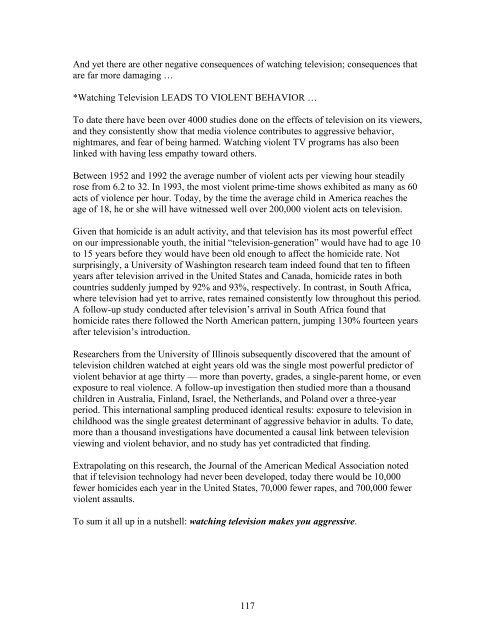Licking the Razor's Edge (2015)
Recognizing the hidden addictions that bind you, … to then set your True Self free
Recognizing the hidden addictions that bind you,
… to then set your True Self free
You also want an ePaper? Increase the reach of your titles
YUMPU automatically turns print PDFs into web optimized ePapers that Google loves.
And yet <strong>the</strong>re are o<strong>the</strong>r negative consequences of watching television; consequences that<br />
are far more damaging …<br />
*Watching Television LEADS TO VIOLENT BEHAVIOR …<br />
To date <strong>the</strong>re have been over 4000 studies done on <strong>the</strong> effects of television on its viewers,<br />
and <strong>the</strong>y consistently show that media violence contributes to aggressive behavior,<br />
nightmares, and fear of being harmed. Watching violent TV programs has also been<br />
linked with having less empathy toward o<strong>the</strong>rs.<br />
Between 1952 and 1992 <strong>the</strong> average number of violent acts per viewing hour steadily<br />
rose from 6.2 to 32. In 1993, <strong>the</strong> most violent prime-time shows exhibited as many as 60<br />
acts of violence per hour. Today, by <strong>the</strong> time <strong>the</strong> average child in America reaches <strong>the</strong><br />
age of 18, he or she will have witnessed well over 200,000 violent acts on television.<br />
Given that homicide is an adult activity, and that television has its most powerful effect<br />
on our impressionable youth, <strong>the</strong> initial “television-generation” would have had to age 10<br />
to 15 years before <strong>the</strong>y would have been old enough to affect <strong>the</strong> homicide rate. Not<br />
surprisingly, a University of Washington research team indeed found that ten to fifteen<br />
years after television arrived in <strong>the</strong> United States and Canada, homicide rates in both<br />
countries suddenly jumped by 92% and 93%, respectively. In contrast, in South Africa,<br />
where television had yet to arrive, rates remained consistently low throughout this period.<br />
A follow-up study conducted after television’s arrival in South Africa found that<br />
homicide rates <strong>the</strong>re followed <strong>the</strong> North American pattern, jumping 130% fourteen years<br />
after television’s introduction.<br />
Researchers from <strong>the</strong> University of Illinois subsequently discovered that <strong>the</strong> amount of<br />
television children watched at eight years old was <strong>the</strong> single most powerful predictor of<br />
violent behavior at age thirty — more than poverty, grades, a single-parent home, or even<br />
exposure to real violence. A follow-up investigation <strong>the</strong>n studied more than a thousand<br />
children in Australia, Finland, Israel, <strong>the</strong> Ne<strong>the</strong>rlands, and Poland over a three-year<br />
period. This international sampling produced identical results: exposure to television in<br />
childhood was <strong>the</strong> single greatest determinant of aggressive behavior in adults. To date,<br />
more than a thousand investigations have documented a causal link between television<br />
viewing and violent behavior, and no study has yet contradicted that finding.<br />
Extrapolating on this research, <strong>the</strong> Journal of <strong>the</strong> American Medical Association noted<br />
that if television technology had never been developed, today <strong>the</strong>re would be 10,000<br />
fewer homicides each year in <strong>the</strong> United States, 70,000 fewer rapes, and 700,000 fewer<br />
violent assaults.<br />
To sum it all up in a nutshell: watching television makes you aggressive.<br />
117


















